Beezone Interview Series

with

‘E’is the feminine principle of immense wisdom and space that pervades all of experience;
![]()
‘VAM’is the masculine principle of indestructible skillful means and compassion, which is also the experience of great bliss.
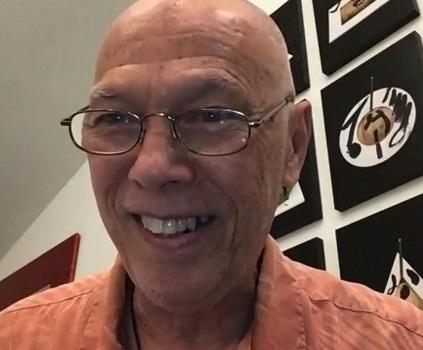
![]()
Ed: Would you tell the audience how you first met Adi Da? I understand that it was not in the body. In fact it was out of any knowledge that it was Him. If I remember you were riding a bicycle and wound up at a Vedanta Temple. Would you start there?
Stephan: Yes, I think that this is probably my first memory of actually contacting Beloved Adi Da as the Guru, without knowing it. I had been a dancer in the gay bars in Hollywood and I had decided to get out of it. The life was just not working out. Too much was happening in my feeling sense, and the whole dancing scene was a nightclub scene, just didn’t feel too happy to me.
I had gotten the job at a health food store and moved to a more central Hollywood area. I was working on Melrose Avenue at the Nature Way Health Food Store. That particular beautiful, sunny, warm, comfortable day, I’m riding my bike around and all of a sudden, I come to this one place that looks like, from my point of view, it looks like a movie set, because it’s not a conventional building. It was in a suburban development where there were home after home, lawn, garden, all that stuff. But this place looks more like something from India, something more Arabian or Indian. I’m not too familiar with all of that, but I’m just noticing it looks like a movie set from another country.
So, I stop and I’m just resting on my bike, looking with a kind of amazement. What is this place? I can’t believe, what am I looking at? It doesn’t fit in the neighborhood. So, I go up toward the front area and I’m just, not only am I amazed at the architecture, but I’m also getting some kind of a feeling sense of something and I don’t even know what it is that I’m feeling, but it’s something that’s moving me, such that I get off of my bike. I put my bike to the side, close to this tree. First I walk up to the front doors of this temple-looking structure and I don’t know what it is. I don’t know if this is a residence, a church, or what, because there’s no sign. There was literally nothing that I could see that I could identify this place from the location where I was standing.
 Listen to the Interview – click triangle
Listen to the Interview – click triangle
So, then I’m just moved to go under the tree and sit down. It’s not like a voice is telling me to do this. It’s just happening, and I “go out”. I don’t even know how to explain it because I didn’t have the practice of meditation at that time of my life. So, I didn’t know what was happening. I just sat down and “zonked out”. Now, I understand what happened. I went into a meditation state, a samadhi of some sort and was just being meditated, I think that is how I would describe it. I don’t actually recall what happened, other than I was out for a while, maybe a half an hour, maybe 45 minutes, maybe less, maybe more. I really don’t know.
And when I came to, I was just feeling this sense of peace, and tranquility, and just this beautiful feeling like I hadn’t felt before. And I simply got up, got back on my bike and rode away. I didn’t try to name it. I didn’t try to figure it out, because my mind had kind of melted and I was just in this feeling place, so there was no need to question it. There was just the gift of feeling it.
Ed: Did you ever return?
Stephan: Oh, I returned years later.
Ed: No, after the event. Sometimes when people find a special spot or a place that spoke to them in some way, be it nature or whatever, it would return to recapture that moment. Did you ever do that?
Stephan: No, I did not.
Ed: At what point in time did you then put two and two together?
Stephan: It was probably a year or two later after I became a devotee or a student, I guess you would call it in those days. I obviously read The Knee of Listening, so I read about the Vedanta Temple. It was some time later that I realized that those were the same two places. The place that I went to and the place that Beloved was at, going through his reawakening, I guess is what it was called. That was the same place. So, it was literally a long time later. It wasn’t an immediate thing that I had that recognition, because basically I’d forgotten about it. See, you asked me if I returned there. No, I not only hadn’t returned there, I didn’t even think about it. It just happened. In other words, it could have been anywhere, at any time. Something happened, and I had no explanation for it. It wasn’t until years later that I understood what it was and who it was.
Ed: All right. This also is synchronistic. The fact that you’re leaving this lifestyle of dancing and being in an environment that is less than, let’s say, healthy, moving into a natural foods store, where you say Nature Way Health Food Store, which happened to be, by coincidence if you will, across the street from the first opening of the Adi Da Ashram.
Stephan: Yes. All of it. I’m glad you said that, Ed, because if you look at not only the incident at the Vedanta Temple and the dissatisfaction with the life of a dancer and the clubbing life, if you look at all that, you do start seeing this process that’s occurring, that’s leading to something else, even though that something else is not really quite known, what it is or who it is, but all of it is happening. And that’s why to me, I was so astounded at this retelling of the story to you, because as I tell you these stories, I’m starting to see that it was all given all along the way. And even back in the St. Michael’s orphanage in Staten Island, when my friend and fellow devotee Charles Sage, was visiting me at the Catholic orphanage back in the early 1950s, all of it, it’s just all connected.
Ed: I think the deeper one explores the awakening process, if you will, just to put a name on something. The process of awakening is always in place. It’s love bliss, or happiness, or what is prior, however you describe it.
“The great signs..associated with…Realization appear only in the context of the absolute frustration of the life-patterns of the would-be ego-“self”. That absolute frustration is the intrinsic and always fundamental “self”-understanding and certainty that the egoic “self” will not-and cannot-be finally fulfilled.”
Adi Da Samraj, The Aletheon
Adi Da teaches understanding so that people will become serious about the Lesson of Life. This is where I see your process because you’ve suffered such in every way, indescribable almost horrific childhood of abuse and abandonment, and you can’t even begin to describe it. But there was nowhere in your life that gave you any hope. At least I can’t hear it in the beginning.
Stephan: No. Yes, exactly. The story that I described of my childhood you’re right (see session two). That was that wounded, victimized, particular play of this character. But what’s extraordinary to me is now that I’m telling you these stories, I am seeing a connection in which the Divine process, consciousness itself, Beloved himself, in who he really is as the Divine. I start seeing how the Divine process was there all along, showing itself in little, little ways and moving this particular character through and like going down a stream, a river stream in which you have all these different experiences, and ideas, and searches, and trials, and tribulations, and then you start getting a sense.
It comes together when you meet the Guru in human form, when you meet the Divine in human form, and then you start seeing all these kind of purifications and miracles that are occurring through this entire process. But it seems like it’s different. It seems like, “Oh yeah, this is, oh, this is like a miracle that’s happening here. What a wonderful thing to meet the Guru.”
But what I’m getting in telling you these stories right now is that the Guru was always there and starting to get the sense that I just picked this particular story of Stephan, the ego, and all of his drama. And boy, can I give you a nice dramatic story of my upbringing and my childhood and so forth and so on. And yet there’s this other story that is prior to it, that is actually the Divine story. That’s exactly what I’m trying try to express myself is that in the reliving, and retelling, and reconsidering all of these stories, I’m starting to observe, and notice, and witness this other story that is much more magnificent bleeding through in this. It’s remarkable to me.
Ed: Yeah. Well, also remarkable to me, because what you have revealed to me in when you talked about how Adi Da responded when you first came into the contact with the Adi Da.
The emotional sexual consideration hadn’t been established, and he would, at times, as you related to me that he would send you with other devotees into a room to talk about, if you will, psychological and emotionally developing times in people’s lives and histories, or times with your parents, and things of that sort. And after one of these sessions where you went into a room and spoke with a number of devotees, and you came out of the room and the … and not Bubba at the time, Adi Da was apparently waiting to hear how it went. The other devotees said they were so taken by your trauma, your early childhood life, that they had no way of even comprehending the suffering and trauma you endured.
Stephan: Yes, you’re absolutely right. And the part that’s mind blowing about it is the fact that it’s, he’s just … Not only is he living and demonstrating the Divine principle and the Divine itself, that he also sees, you’re not separate from that whatsoever. And yet you believe a story of yourself that is, and you’re talking, you’re living it, you’re animating it. And you’re convincing others, the truth of that story.
Ed: Well, it’s not just like you doing it. You are given a program in life before you’re even cognitively capable of understanding anything as a young child and infant. You were being imprinted by it all.
Stephan: So it seems.
Ed: Well, it is. In fact, when the verbal capability and the cognitive mind starts to develop and the understanding of a ‘me’ develops. The identity of, “Oh, my name is Joe, or Frank, or Sam, or Mary, or Ellen.” These things start to develop as a young child, you can’t expect a young child to have the capability of the radical nature of what we’re speaking about. It’s only in the responsibility of growing up and becoming a little bit, if you will, savvy to the story, your script. Not only your story, but the world’s story and everybody else’s story. Everybody, the whole thing is conformed to perpetuate the understanding that we live in the year 2020, you’re you, me is me and George Washington cut down an apple tree!
Stephan: I know. It seems the more I think about that, and just consider it a little bit from Beloved’s point of view or from the Divine point of view that there is only consciousness itself, only Light itself. So, when you think about it from that point of view, it’s a cartoon. Everyone’s in a cartoon, and they’re believing it. They’re talking about it, and they’re animating it, and they’re having dramas about it. But the truth of the matter is it’s all just a bit of theater.
“My “Consideration” with you is artful theater of breaking through the presumption that is your own illusion.”
Are You In My Room? – Adi Da Samraj
Ed: Think of the stories that are embedded, moral backbone of the civilization that you live in. You’re undermining some very fundamental beliefs people live and die by.
Stephan: No, it’s true. Yeah. Well, yeah. That’s true. That’s what the Guru does. Light over dark. It just shines the light and then shows that all of this stuff is just the self-contraction.
Ed: That’s the fundamental difference between Him and the six stages of life that other people, and realizers, and other forms of cultural, spiritual awakenings teach, because at some point in time after the third and into the fourth stage of life, from Adi Da’s perspective, as you well know, this stuff disappears in terms of the cultural baggage of it all.
There were periods of time that we spoke about earlier, and we’ll get into them in the other sessions, that you were given a period of time of ecstatic identification with deities, with forms of subtle spiritual identities as a spiritual being.
Stephan: Yeah, It was a wonderful holiday, a vacation! All on another plane, another realm. Those were wonderful, enjoyable things, like Disneyland. But he also did it with … as you know, during Garbage and the Goddess, the different periods of time, he just had hundreds, and hundreds, and hundreds of people literally just “bonkers”, out of their minds with spiritual experiences, like night and day, every day, constantly. I remember once sitting on the porch in the circle of the Mountain of Attention sanctuary, there. I was living there. And there was just, on the weekend, all the people would come up from San Francisco and surrounding areas.
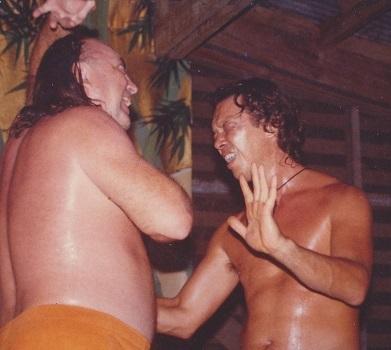
Adi Da Samraj and Stephan
“No experience is necessary or identical to Truth”
Experiences Are a Demand, Not a Path
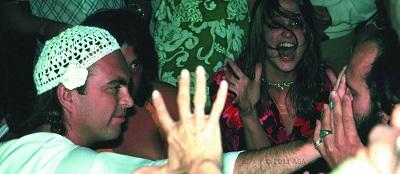
So there were just hundreds and hundreds of people, all of a sudden. And they’re all having all sorts of kriyas. And I’m watching them on my porch as they’re trying to walk from one place to the next, from the parking lot to the hotel, or the dining room, or whatever. And they literally, everybody is falling on the ground having kriyas. And I’m watching this. We’re watching it, and having them ourselves, too, as like, “Whoa, what the hell’s going on, here?” Talk about an asylum. Oh my goodness. There’s just … notice all, that this is what was being demonstrated.
But now looking back, and what we realize is that he was only demonstrating one thing. And that was there is … and he was saying it, too. But he wasn’t just saying it. He was actually showing us, except for, like you said, we could easily deny or forget, or get distracted and forget the true situation, which is that there is only the Divine, that’s all there is. That’s all that’s ever going on. There is nothing else going on. That’s why He can say, “There is nothing to attain. Have I said it?”

If you’re presuming the separate self sense, then, yeah, of course then the whole thing is absolutely real. All the suffering, you can justify or make sense of it all.
Ed: Which is just basically a rationalization for staying in the embodiment of moral righteousness. Defending not only the suffering of the world but your own – and the worlds – moral dilemma. Because you can’t square the horrific happenings in this world in a moral context, everybody is going to stay within that moral framework, looking for an answer. “And, well, what about my aunt, Mary, who is a good person, and she died in a rotten car accident?” or whatever. All these incongruent, moral happenings in the world. And now we’re facing a virus pandemic. We have upheavals all over the world, and evil is apparently showing itself in leadership and politics, and people being killed by police, and people are looking for some kind of moral righteousness and then someone or something to blame – a scapegoat.
“This manifestation is a plane of universal sacrifice. It is a process in which all forms appear, continue for a while, are subject to intrusions, apparent differences, effects, and then die-but without bringing an end to life or the process itself, without bringing an end to Consciousness Itself. And there is nothing you can do about it-not absolutely, to the point of perfection, to the point of moral righteousness-absolutely nothing.”
The “Reality” You Are Asking Questions About Is Your Own Illusion
Stephan: Isn’t it interesting, Ed, while all of this is going on, that you just said, you and I are sitting here and what are we actually talking about? And what are we actually being amazed about and being heart touched about? So I think it’s a very interesting dichotomy and I do believe, not believe, I know for sure, actually, that you do become what you meditate on.
Ed: Well, that’s fundamentally the case. I’m reminded of a piece in the Urgency of the Teaching, where he says, “The force of the Divine pervades everything, and therefore it also purifies in one way or another.” “If human beings, while they have the benign capacity to enter into God’s communion will not do so, but instead create a corrupt culture, a subhuman order, then the purification will not occur within the ordinary and benign course of natural processes. It is then no longer a matter of some Adept saying a holy word or speaking the truth.” – The Urgency of the Teaching
This is where the responsibility shifts. Everybody wants to be devotional, be on the right side and believe in God, but Adi Da brings the responsibility of that righteous principle, if you will, to the responsibility of everyone, personally, individually.

There is Only One Responsibility
Stephan: What’s happening in this … Well, I can’t call it just a conversation, because for me, it really is an incredible puja, a sacred event is what we’re participating in, what’s occurring and also what’s coming from it, the results of it. And it is that responsibility in consciousness to gift, to protect this gift, and live this gift, and assume there was this gift. And therefore, a lot of the other things that one may be distracted in and take as important, and invest time, and energy, and attention into start falling away. They really do. They start falling away and it’s just … You don’t have the sense that they’re worth too much energy and attention to be invested into. It’s not a negative. It’s just that things just start dropping away. So what do you want to do? What you want to do what supports and serves this process that you’re understanding.
Ed: Well, this is where he says, “Realization and renunciation are absolutely coincidence. They go together.” Because what you’re talking about is these patterns of behavior that need to be taken care of, adapted to, and transcended. Because you can’t jump over the responsibility of life.
“The problem with Stephan is he relates to me as an other.”
Stephan: So Ed, while we’re talking another thing, I just remembered something Beloved’s called out on me, personally. And even though so often he would use me as an example of a good devotee, a good demonstration of a devotee, or something like that. But then he would also do the opposite, too. So there’s this one time he said in a gathering, in front of me, he said, “Well.” He said, “The problem with Stephan is he relates to me as an other.” Now, of course, that, again, that’s like a koan It’s the Guru. There’s the Guru, right? Or he’s over there feeding the body.
And he’s talking, and he’s revealing sorts of incredible things that he’s making you laugh, and he’s making you cry, and your heart is breaking. So there’s all of that. And you meditate on them. You go into the hall and you meditate on them. You even say prayers to him and all that stuff. And yet he tells me that I’m relating to him as an other. And that’s the error that I am making. I couldn’t understand that. I knew what the words meant. I knew for there to be an other, you have to assume separateness, the separate self sense. I understood the argument academically, but how the hell was I going to do anything about it? You know what I’m saying?
Ed: Yeah, this is the crux, what he was shouting about up until his mahasamadhi.
Stephan: Well, it’s just what we were talking about earlier. Turn to me, turn to me, turn to me. So you try, doing the best you can of turning to the Divine, turning to the Guru, turning to the mystery, whatever, however you want to name it, and that instruction. And now, that I’m speaking about it now, at 70 years old and not 30, when he said it or however old I was, I understand it, now. I actually do understand it. You know?
Ed: Right.
Stephan: I was, more at that point in time, and in terms of the maturity and understanding the Guru, the relationship and all that stuff, I was more animating a cultic, in some sense, like a cult person, a cult member where you think of a deity as an other, and you worship that deity. And whereas if you really get a sense of worshiping and relating to the Divine, you do eventually see that it really is not an other. Oh yeah, there is the Guru. There is that kind of dichotomy of yes there is … Adi Da Samraj really did exist and live amongst us and all that. But being that he never presumed a separate self sense, and he never animated it. Then who was he?
He was all the things that was human, and true, and right there, and all that.
“it is a time for…true devotees to reappear if there is to be any hope for the future of human beings. The cults…have become frozen in their idolatry, fixed in their association with their historical…limitations, and they do not represent a window to the Living God anymore. They represent a piece of mind frozen in the form of words and imagery…”
Ed: As he so plainly said from the very beginning, he’s a paradox. And this is why people have to stay with the process, otherwise at some point in one’s development they will come up with some kind of a conclusion and then He’s FROZEN, dead.
Stephan: And you know what? Whether they do or they don’t, whether they’re able or they’re not, whatever their presumption is, it doesn’t even matter. I’m telling you, I know, the fact that we can have this conversation and talk about the actual gift that the Divine gives, which is the Divine in himself, itself and consciousness itself, that we can even be discussing it. And the truth of it, that that was actually what was going on all along.
We’ve even started discussing it prior to meeting the Guru over and over again, where there were those moments of gifts of the animation of the Divine, out of nowhere, you working in a mental institution being flooded with it in this. And me also in a mental institution. I was the patient at the time, I decided to play the role of the patient, the victim. You were playing the role of an educator. But it doesn’t really matter. That’s what he was addressing when he had Annie and I stand up (see session three). It doesn’t really matter. None of it really matters. There really is Only the Divine, and that’s what is being shown and demonstrated. And that’s what you and I get to talk about. Hallelujah!
Ed: The time you and Annie were told to stand up really exemplifies the fundamental nature of what Adi Da talks about when he refers to the self-contraction and the radical argument of going to the ‘root’. That really is the fundamental core of everything. It’s the root, as he says. That’s why I called it radical, a radical teaching to the root.
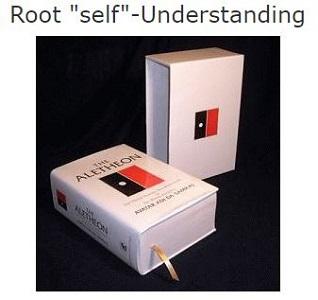
 Listen to Stephan describe the interaction with Adi Da, Annie and himself – click triangle
Listen to Stephan describe the interaction with Adi Da, Annie and himself – click triangle
Stephan: Well, that’s what I’m really enjoying about these conversations that you and I are having. That’s what I’m really enjoying is that we actually get to relive, remember, acknowledge through this conversation, that the greatness of what we have been given and received by this relationship with the Guru. And who’s the Guru? He ain’t an other, you can’t call him an other. That’s a mistake.

Ed: I’m reminded of that. And I will have to end pretty soon, here, but I’m reminded of the time when he was standing in front of the gathering in 2005, One of the last Avatar Discourses. He was talking about this paradox. And he says, “I’m here, but where is here?” And He gets into this whole thing about where is here. “I’m here. Yes, I’m here, but I’m not here. This is not where I am.” And he’s speaking about this place of prior to the body, prior to the mind, prior transcending, all of the appearances, all the illusions, all the Maya on the reflection of consciousness, because he was so deep in that Heart Transmission. Amazing.
Stephan: Yes, it is amazing, He IS!
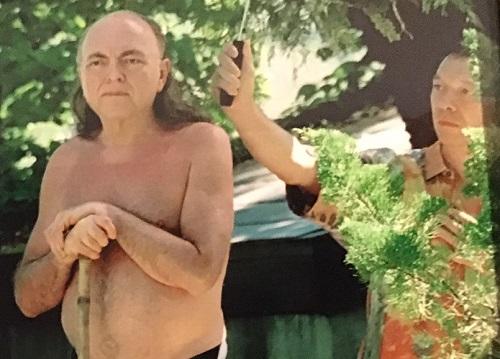
Adi Da Samraj and Stephan, 2000